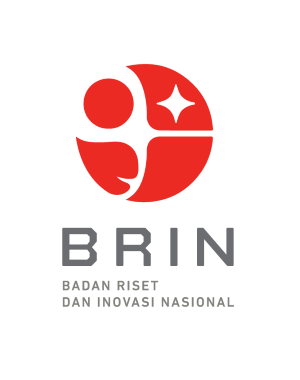AKTIVITAS OSMOREGULASI IKAN CAPUNGAN TITIK HITAM (Sphaeramia orbicularis) PADA LINGKUNGAN BERSALINITAS
DOI:
https://doi.org/10.33096/joint-fish.v7i1.405Keywords:
Cardinals, osmoregulasi, salinitas, Sphaeramia orbicularisAbstract
Osmoregulation in fish is a process that involves regulating the balance of water and electrolytes in their bodies, especially changes in salinity in the water environment where they live. This study aims to determine the osmoregulatory ability of orbiculate cardinalfish (Sphaeramia orbicularis) to changes in salinity. This research used a Completely Randomized Design (CRD) with four treatments, namely control (no treatment), 150 mL fresh water/L sea water, 100 mL fresh water/L sea water, and 50 mL fresh water/L sea water and respectively three repetitions each. orbiculate cardinalfish with a length ranging from 5.2 ± 0.46 cm and a weight of 2.3 ± 0.25 g were kept in each rearing container and given treatment based on each treatment. The parameters observed in this study were the fish's osmoregulatory ability by looking at fish behavior, external organs (fish skin and gills), and examination of internal organs (kidneys), and survival rate. The results showed that the control treatment at the end of the study had abnormal kidney and gill conditions. Meanwhile, the dilution treatment of 150 mL fresh water/L sea water, 100 mL fresh water/L sea water, and 50 mL fresh water/L sea water showed normal conditions or symptoms in the kidneys and gills, but the fish skin organs showed pale or faded in all treatments. Based on these results it can be concluded that the best treatment is 150 mL fresh water/L sea water treatment.
References
Abidin, J., & Ohorella, M. (2017). Peranan salinitas terhadap kelangsungan hidup dan pertumbuhan ikan kupu-kupu (Chaetodon Kleinii). MUNGGAI: Jurnal Ilmu Perikanan & Masyarakat Pesisir, 3, 1–7. https://id.orphek.com/butterflyfish-compatibility-with-corals/.
Árnason, T., Magnadóttir, B., Björnsson, B., Steinarsson, A., & Björnsson, B. T. (2013). Effects of salinity and temperature on growth, plasma ions, cortisol and immune parameters of juvenile Atlantic cod (Gadus morhua). Aquaculture, 380–383, 70–79. https://doi.org/10.1016/j.aquaculture.2012.11.036
Boeuf, G., & Payan, P. (2001). How should salinity influence fish growth? Comparative Biochemistry and Physiology Part C: Toxicology & Pharmacology, 130(4), 411–423.
Choi, K., Cope, W. G., Harms, C. A., & Law, J. M. (2013). Rapid decreases in salinity , but not increases , lead to immune dysregulation in Nile tilapia, Oreochromis niloticus ( L .). Journal of Fish Diseases, 36, 389–399. https://doi.org/10.1111/j.1365-2761.2012.01417.x
Effendie, M. I. (1997). Biologi Perikanan (p. 163). Yayasan Pustaka Nusatama.
Fielder, D. S., Allan, G. L., Pepperall, D., & Pankhurst, P. M. (2007). The effects of changes in salinity on osmoregulation and chloride cell morphology of juvenile Australian snapper, Pagrus auratus. Aquaculture, 272(1–4), 656–666. https://doi.org/10.1016/j.aquaculture.2007.08.043
Fujaya, Y. (2004). Fisiologi Ikan Dasar Pengembangan Teknik Perikanan. Rineka Cipta.
Gunawan, Setiawati, K. M., & Hutapea, J. H. (2011). Produktivitas induk ikan capungan banggai Pterapogon kauderni F0 dan F1 di Hatcheri. Prosiding Forum Inovasi Teknologi Akuakultur, 1(1), 1211–1216.
Hadijah, S., Abubakar, J., Hamdilah, A., & Yunus, M. (2022). Analisis Penggunaan Keong Emas sebagai Pakan untuk Mensubtitusi Pellet pada Ikan Kakap Putih (Lates calcarifer). Journal of Indonesian Tropical Fisheries, 5(1), 12–26.
Kasmi, M., & Rahman, S. A. (2015). The Dosage of Saline Water Dilution on The Osmoregulatory Capacity of Clownfish (Amphiprion ocellaris). IOSR Journal of Agriculture and Veterinary Science Ver. I, 8(10), 74–78. https://doi.org/10.9790/2380-081017478
Pamungkas, W. (2012). Aktivitas Osmoregulasi, Respons Pertumbuhan, dan Energetic Cost pada Ikan yang Dipelihara dalam Lingkungan Bersalinitas. Media Akuakultur, 7(1), 44–51. https://doi.org/10.15578/ma.7.1.2012.44-51
Poernomo, A., Mardijah, S., Ginting, M. L., Amin, E. M., & Widjopriono. (2009). Ikan Hias Laut Indonesia. In Penebar Swadaya (4th ed.). Penebar Swadaya. ???
Praseno, O., Krettiawan, H., Asih, S., & Sudradjat, A. (2010). Uji Ketahanan Salinitas Beberapa Strain Ikan Mas yang Dipelihara di Akuarium. Prosiding Forum Inovasi Teknologi Akuakultur, 93–100.
Primiani, C. N., & Dewi, A. R. (2019). Pengaruh salinitas pada kelangsungan hidup dan struktur jaringan insang ikan nila (Oreochromis niloticus). Prosiding Seminar Nasional Hayati VII Tahun 2019, 7(September), 13–19.
Purwatiningrum, O. (2018). Description of Communal Domestic Wastewater Treatment Plant in Kelurahan Simokerto, Kecamatan Simokerto, Kota Surabaya. Jurnal Kesehatan Lingkungan, 10(2), 243–253. https://doi.org/10.20473/jkl.v10i2.2018.211-219
Rahman, S. A., Athirah, A., & Asaf, R. (2017). Konsentrasi Pengenceran Salinitas Terhadap Kemampuan Osmoregulasi Ikan Capungan Banggai (Pterapogon kauderni). SAINTEK Peternakan Dan Perikanan, 1(1), 45–51.
Rahman, S. A., & Safir, M. (2018). Performa Pertumbuhan dan Kelangsungan Hidup Ikan Capungan Banggai (Pterapogon kauderni) pada Mikrohabitat yang Berbeda. Octopus, 7(2), 1–6.
Randall, D., Burggren, W., French, K., & Fernald, R. (1997). Eckert Animal Physiology Mechanisms and Adaptations. In W.H. Freeman and Company. https://doi.org/10.1111/1540-6229.00227
Ranggana, H., Lumbessy, S. Y., & Lestari, D. P. (2023). Pengaruh Penggunaan Pakan Maggot (Hermetia Illucens) terhadap Pertumbuhan dan Kelangsungan Hidup Ikan Mas (Cyprinus carpio). Journal of Indonesian Tropical Fisheries, 6(1), 1–11.
Sabono, M. M., Undap, S. L., & Longdong, S. N. J. (2020). Konsentrasi merkuri ikan capungan cardinalfish (Sphaeramia orbicularis) di area budidaya perairan pintu Kota Kecamatan Lembeh Utara, Bitung. E-Jurnal Budidaya Perairan, 8(1), 48–56.
Wilmer, J. B., Germine, L., Chabris, C. F., Chatterjee, G., Williams, M., Loken, E., Nakayama, K., & Duchaine, B. (2010). Human face recognition ability is specific and highly heritable. Proceedings of the National Academy of Sciences of the United States of America, 107(11), 5238–5241. https://doi.org/10.1073/pnas.0913053107
Zhang, Y., Mai, K., Ma, H., Ai, Q., Zhang, W., & Xu, W. (2011). Rearing in intermediate salinity enhances immunity and disease-resistance of turbot (Scophthalmus maximus L.). Acta Oceanologica Sinica, 30(4), 122–128. https://doi.org/10.1007/s13131-011-0141-4













